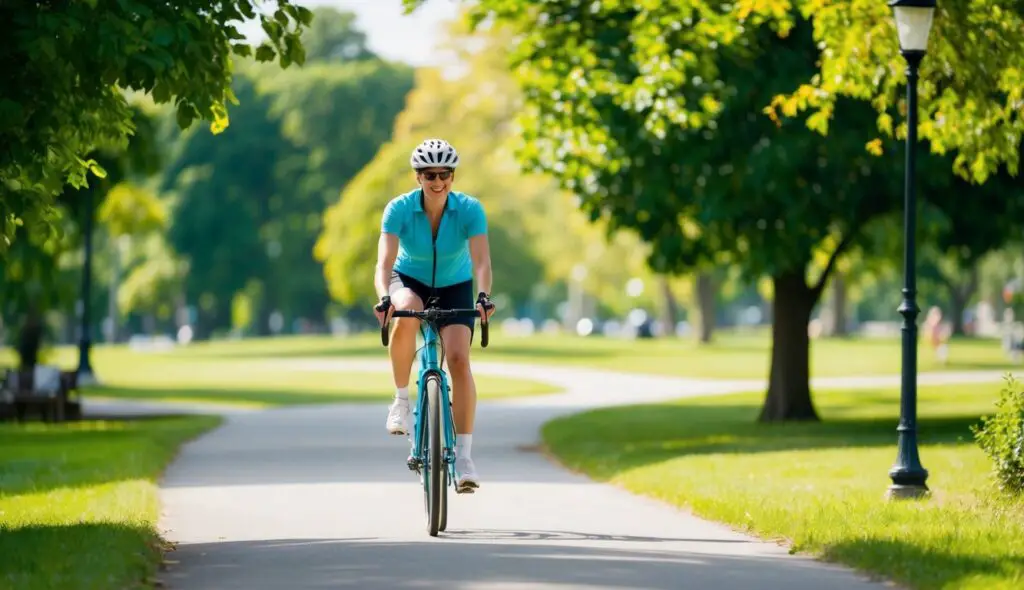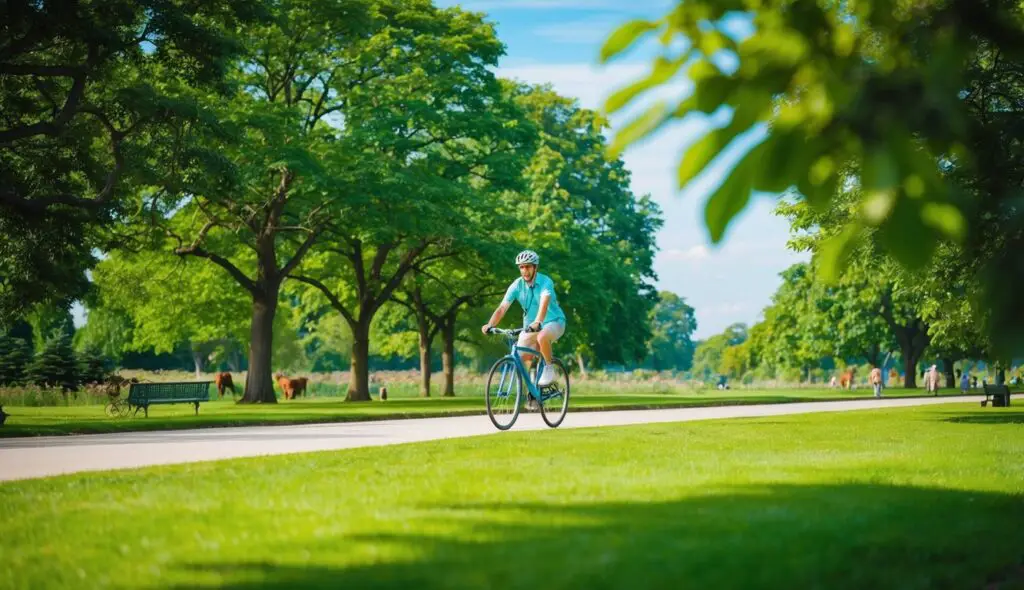Bike riding offers a range of benefits that can enhance both physical health and overall lifestyle.
Cycling is not just an enjoyable activity; it is a powerful form of physical activity that promotes cardiovascular health, strengthens muscles, and helps maintain a healthy weight.
Additionally, incorporating bike riding into daily routines can significantly reduce one’s carbon footprint, making it an environmentally friendly mode of transportation.
Many individuals find that cycling provides a sense of freedom and adventure.
Riding a bike can improve mental well-being by reducing stress and anxiety, while also increasing energy levels.
Whether commuting to work or exploring new trails, bike riders experience both the joys of outdoor activity and the positive impact of staying active.
With the right bike and safety gear, anyone can enjoy the numerous health benefits while contributing to a cleaner environment.
Each ride is a step toward better health and a sustainable future.
Health and Fitness Advantages

Bike riding offers numerous health and fitness advantages that enhance overall well-being.
It supports cardiovascular health, builds muscle strength, aids in weight management, protects joints, and boosts mental health. Each of these areas plays a critical role in leading a healthy lifestyle.
Cardiovascular Improvement
Cycling is an effective aerobic exercise that strengthens the heart.
Regular bike riding can lower resting heart rate and improve circulation. This leads to enhanced oxygen flow throughout the body, making daily activities easier.
In addition, cycling can lower the risk of heart disease.
It not only helps to lower blood pressure but also improves cholesterol levels. Engaging in cycling for at least 150 minutes each week can bring significant cardiovascular benefits.
Muscle Strength and Toning
Bike riding engages various muscle groups, primarily in the lower body.
Key muscles used include the quadriceps, hamstrings, glutes, and calves. Over time, consistent cycling leads to increased muscle strength and tone.
As riders push against the pedals, they build endurance and power.
The repetitive motion helps in developing leg muscles effectively without the strain that comes from high-impact activities. This makes cycling a gentle yet effective way to tone muscles.
Weight Management and Metabolism
Cycling burns calories, making it a useful tool for weight management.
A person can burn approximately 400-1000 calories per hour depending on intensity and body weight. This calorie expenditure supports healthier body composition.
Additionally, bike riding can enhance metabolism, even after the ride is over.
Regular cyclists can benefit from an increased resting metabolic rate, which helps in maintaining a healthy weight. This is an important factor in fighting obesity and related health issues.
Joint Protection and Bone Health
Cycling is low-impact, which is beneficial for joint health.
Unlike running, it places less stress on the knees and hips. This makes it a suitable exercise for people with arthritis or osteoarthritis.
The motion of pedaling helps to lubricate joints and improve flexibility.
Furthermore, cycling promotes bone health by enhancing bone density without risking injury. This contributes to stronger bones over time, reducing the risk of fractures.
Mental Health and Cognitive Function
Bike riding also positively impacts mental health by reducing anxiety and depression.
The release of endorphins during exercise can lead to feelings of happiness and relaxation. It offers a productive outlet for stress and enhances mood.
Moreover, regular cycling can improve cognitive function.
Focusing on balance, coordination, and the road can sharpen concentration and mental clarity. Engaging in outdoor cycling may additionally improve sensory perceptions and spatial awareness.
Safety and Form

Maintaining safety and proper form while biking is crucial for a good riding experience.
Proper Riding Techniques
Good form on a bike starts with posture. Riders should sit up straight, keeping their shoulders relaxed and elbows slightly bent. This position allows for better control and comfort over long distances.
The saddle height is also important.
It should be adjusted so that the rider’s leg is almost fully extended when the pedal is at its lowest point. This adjustment reduces the risk of knee strain.
Riders should practice smooth pedaling and avoid sudden movements.
Making gradual turns and using both brakes evenly allows for safer maneuvers. Practicing these techniques can improve overall riding efficiency.
Essential Safety Gear
Wearing the right safety gear significantly reduces injury risk.
A properly fitted helmet is vital for head protection and should always be worn while biking. It should fit snugly and be adjusted to sit level on the head.
Additionally, bright and reflective clothing can make riders more visible, especially in low light.
Wearing gloves can improve grip and comfort, while padded shorts enhance saddle comfort for longer rides.
Sunscreen is also essential for outdoor riders. Applying it can protect exposed skin from harmful UV rays, especially on sunny days.
Risks and Precautions
Biking carries some risks, but many can be minimized with precautions.
Road hazards like potholes or gravel can lead to accidents, so riders should always be alert.
Cyclists should avoid headphones to stay aware of their surroundings.
It’s also important to follow road signs and signals, ensuring safe interactions with vehicles.
Before heading out, it’s wise to check the bike for any maintenance issues.
Flat tires, worn brakes, and loose parts can all lead to accidents. Taking these simple steps can significantly enhance safety while riding.
Riding for Specific Goals

Bike riding can serve various purposes, such as improving athletic performance, supporting rehabilitation, or providing an efficient way to commute. Each of these goals has distinct benefits and considerations.
Training and Performance
Cycling enhances physical performance through targeted training.
It develops coordination and balance, essential for efficient riding. Riders can improve their endurance and strength by including interval sessions and long rides in their routine.
Strength training on a bike focuses on building muscle in the legs and core. This is crucial in boosting overall cycling efficiency.
Regular cyclists can also experience benefits related to heart health and weight management, which help reduce the risk of type 2 diabetes.
Additionally, riders can track their progress using various metrics, including speed and distance, which can be motivating and provide clear goals.
Rehabilitation and Therapeutic Use
Bike riding is an effective tool in physiotherapy for those recovering from injuries.
It offers a low-impact workout that minimizes stress on joints. This makes it suitable for individuals with mobility issues or chronic pain.
Cycling helps rebuild strength and improve coordination and balance, vital for recovery. For conditions like arthritis, it promotes flexibility without intense pressure.
Healthcare professionals often recommend cycling for rehabilitation, as it assists in restoring range of motion. This method can also uplift mental health, offering a sense of achievement for those overcoming physical challenges.
Urban Commuting and Daily Travel
Biking serves as a practical option for urban commuting.
It provides a quick, efficient way to navigate through traffic, reducing travel time. Cycling can also enhance physical fitness by integrating exercise into daily routines.
In cities, bike lanes and paths make riding safe and accessible. This encourages more people to adopt cycling as a primary mode of transportation.
Furthermore, biking reduces reliance on vehicles, leading to lower emissions and a smaller carbon footprint.
This shift supports environmental sustainability while promoting an active lifestyle.
By choosing cycling for commuting, individuals contribute positively to their health and the community.
Lifestyle and Environmental Impact

Bike riding positively affects both lifestyle choices and the environment. It encourages a healthier way of living while also contributing to lower air pollution levels. The following sections highlight how cycling serves as a sustainable choice and the social benefits it brings to communities.
Cycling as a Sustainable Choice
Riding a bike is a strong choice for those seeking an environmentally friendly lifestyle.
It reduces reliance on cars, which are major sources of air pollution. Each bike ride contributes to lower carbon emissions, making the planet healthier.
Using bicycles can also ease traffic congestion. When more people cycle, there are fewer cars on the road. This not only cuts down on harmful exhaust fumes but also creates cleaner air overall.
In addition, biking requires fewer resources for maintenance compared to vehicles. This leads to less industrial waste and promotes a more sustainable approach to transportation.
Communities benefit significantly from the shift toward cycling, creating a cleaner and more pleasant environment.
Community and Social Benefits
Cycling fosters community connections and enhances quality of life.
Regular bike riders often engage with others who share similar interests. This builds stronger social ties and encourages community activities.
Community bike events and group rides can increase awareness of cycling benefits. Such gatherings promote safe riding practices and strengthen local networks.
As more people join in, the community becomes more vibrant and united.
Moreover, municipalities that invest in bike-friendly infrastructure support healthier lifestyles.
Improved bike paths and facilities encourage more individuals to choose cycling over driving. This shift can lead to lower healthcare costs and a more active population, benefiting society as a whole.
Types of Cycling and Equipment
Cycling offers various styles and equipment tailored to different preferences and environments. Each type provides unique benefits, along with specific gear that enhances the riding experience.
Outdoor Versus Indoor Biking
Outdoor cycling takes place on roads, trails, or parks.
Riders enjoy fresh air and scenic views, which can enhance motivation. Options include road bikes, designed for speed, and beach cruisers, known for comfort on casual rides. Recumbent bikes also fall into this category, offering a laid-back position that reduces strain on the back.
Indoor cycling typically uses a stationary bike. This setup allows for workouts regardless of weather conditions. Many people prefer this for convenience and safety.
Indoor cycling can include structured classes, improving fitness levels through set routines.
Choosing the Right Bike and Accessories
Selecting the right bike is crucial for comfort and performance.
Road bikes are lightweight and geared for speed, suitable for long distances. Beach cruisers provide an upright position, ideal for relaxed riding along the coast.
For those seeking comfort, recumbent bikes feature supportive seats and pressure-relieving saddles, which can reduce discomfort during long rides.
In addition to bikes, accessories play an essential role.
A comfortable helmet ensures safety, while bike lights and a sturdy lock enhance security. Using ergonomic grips can increase comfort during longer rides. Investing in quality gear can greatly improve the overall cycling experience.
Practical Advice and Tips
Having a solid plan for biking can enhance the overall experience. Proper routines, nutritional strategies, and adapting to different conditions are crucial for enjoyable and effective rides. Here are some key considerations.
Building a Riding Routine
Creating a regular riding schedule is essential for making progress. It’s recommended to engage in moderate-intensity physical activity for at least 150 minutes per week. This can be achieved through cycling at a comfortable speed.
Cyclists should consider varying their routes. Including hills in training helps build strength and stamina. A mix of flat and hilly terrains will keep rides interesting while improving fitness levels.
Cyclists can also set specific goals, such as distance or duration. Tracking these goals makes it easier for them to stay motivated. Setting a regular time for rides can build a habit that encourages consistency.
Nutrition and Hydration
Proper nutrition fuels performance. Before a ride, a light meal including carbohydrates and proteins can provide energy. Foods such as bananas, oats, or yogurt are good options.
During rides, especially those over an hour, hydration becomes crucial. Drinking water every 15-20 minutes helps maintain performance. For longer rides, electrolyte drinks are beneficial.
After biking, a recovery meal including both protein and carbohydrates facilitates better muscle recovery. For example, a smoothie with protein powder and fruit can replace lost nutrients and improve energy levels.
Adapting to Weather and Terrain
Weather conditions can impact cycling experiences. Dressing in layers allows cyclists to adjust to changing temperatures.
Lightweight, breathable fabrics help wick away moisture.
Rain can make roads slippery. Cyclists should adjust speed and be cautious around turns.
Cyclists should also consider tire pressure. Lower pressure can enhance grip.
Terrain changes also require different strategies. When approaching hills, cyclists should shift to an easier gear to maintain speed without overexerting.
Planning rides that incorporate various terrains provides a broader challenge and keeps the biking experience engaging.
Leave a Reply